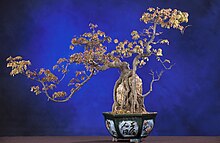Acer buergerianum
| Trident maple | |
|---|---|

| |
| Scientific classification | |
| Kingdom: | |
| (unranked): | |
| (unranked): | |
| (unranked): | |
| Order: | |
| Family: | |
| Genus: | |
| Species: | A. buergerianum
|
| Binomial name | |
| Acer buergerianum Miq. 1865
| |
| Synonyms[1] | |
| |
Acer buergerianum (trident maple; Chinese: 三角枫 san jiao feng) is a species of maple native to eastern China (from Shandong west to southeastern Gansu, south to Guangdong and Taiwan, and southwest to Sichuan) and Japan.[2][3]
Description
It is a small to medium-sized deciduous tree reaching a height of 5–20 m with a trunk up to 50 cm diameter. The leaves are in opposite pairs, 2.5–8 cm long (excluding the 2–5 cm petiole) and 3.5–6.5 cm broad, hard, glossy dark green above, paler below, usually with three lobes; on mature trees the lobes forward-pointing and with smooth margins, on young trees with more spreading lobes and serrated margins. The flowers are produced in spring, yellow-green, in pendulous corymbs; they are small, with five greenish sepals and five yellow-white petals about 2 mm long, and eight stamens. The fruit is a samara with two winged seeds, each seed 4–7 mm diameter, with a 15 mm wing; the wings are forward-pointing and often overlapping each other.[2][4][5]
The species is variable, and a number of varieties have been described:[2]
- Acer buergerianum var. buergerianum. Hubei, Hunan, Jiangsu, Jiangxi, Shandong, Zhejiang.
- Acer buergerianum var. jiujiangense Z.X.Yu. Jiangxi.
- Acer buergerianum var. horizontale F.P.Metcalf. Southern Zhejiang.
- Acer buergerianum var. formosanum (Hayata ex Koidzumi) Sasaki. Taiwan (endemic).
- Acer buergerianum var. kaiscianense (Pampanini) W.P.Fang. Gansu, Hubei, Shaanxi.
- Acer buergerianum var. yentangense W.P.Fang & M.Y.Fang. Zhejiang.
A few trees have consistently unlobed leaves; these were first described as a variety A. trifidium var. integrifolium Makino (A. trifidium is an old synonym of A. buergerianum), but are now not distinguished from the species.[6] Occasional unlobed leaves also occur on most trees with otherwise normal three-lobed leaves.[7]
Cultivation
It is widely grown in temperate regions as an ornamental tree. It was introduced very early to Japan, where its name translates as "China maple".[5][8] More recently, it was introduced to Europe and North America in 1896, and is now occasionally grown in parks and large gardens there.[7] Mature examples may be seen at Westonbirt Arboretum in England, the Esveld Aceretum in Boskoop, Netherlands, Arnold Arboretum in Boston, Massachusetts and many other locations.[4]
Bonsai

Trident maple is a popular choice for the art of bonsai and responds well to techniques that create leaf reduction and ramification,[4] is suitable for many style and sizes of bonsai.[9]
Cultivars
Several interesting cultivars have been developed, many of these bear Japanese names. Notable cultivars include 'Goshiki Kaede' (striking pink and green variegation), 'Kifu Nishiki' (roundish, almost un-lobed leaves), 'Mino Yatsubusa' (dwarf with long, narrow leaves) 'Mitsubato Kaede' (distinctive cork-like trunk) and 'Naruto' (strongly incurved leaf surface).[4]
References
- ^ The Plant List, Acer buergerianum Miq.
- ^ a b c Flora of China (draft): Aceraceae
- ^ Germplasm Resources Information Network: Acer buergerianum
- ^ a b c d van Gelderen, C.J. & van Gelderen, D.M. (1999). Maples for Gardens: A Color Encyclopedia
- ^ a b Rushforth, K. (1999). Trees of Britain and Europe. Collins ISBN 0-00-220013-9.
- ^ Makino Herbarium, Tokyo: Acer trifidium
- ^ a b Mitchell, A. F. (1974). A Field Guide to the Trees of Britain and Northern Europe. Collins ISBN 0-00-212035-6
- ^ Kanon tree book: Acer buergerianum (in Japanese; google translation)
- ^ D'Cruz, Mark. "Ma-Ke Bonsai Care Guide for Acer buergerianum". Ma-Ke Bonsai. Retrieved 2011-07-05.



